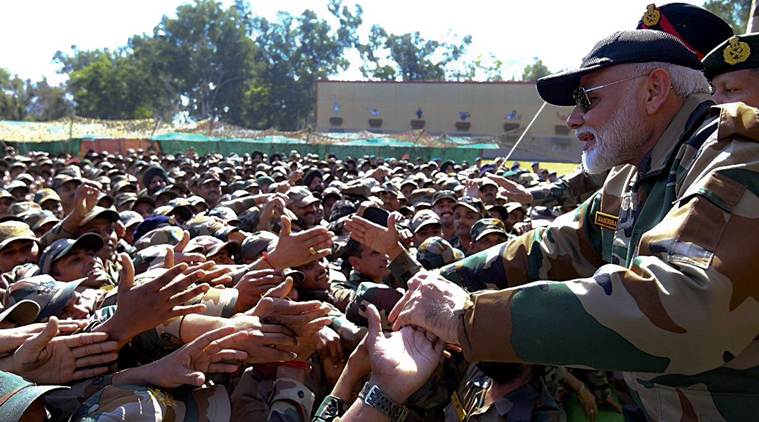Stay updated with the latest - Click here to follow us on Instagram
Before Ayodhya, PM Modi says ‘dignity of judiciary’ was ‘honoured’ in 2010
The five-judge bench headed by CJI Ranjan Gogoi, which reserved its verdict on October 16 after conclusion of the 40-day hearing, is expected to deliver its judgment by mid-November, before the CJI retires on November 17.
 PM Narendra Modi with Army personnel in J&K’s Rajouri district on Sunday, (ANI)
PM Narendra Modi with Army personnel in J&K’s Rajouri district on Sunday, (ANI)
In the final days before the Supreme Court’s expected verdict on the Ayodhya issue, Prime Minister Narendra Modi on Sunday recalled how the “government, political parties, social organisations, civil society, representatives of all sects” prevented attempts to create fissures in 2010, when the Allahabad High Court delivered its ruling in the case.
While Modi did not mention the impending Supreme Court ruling, his reference to the issue seemed to be a veiled suggestion to abide by the court’s order. The five-judge bench headed by CJI Ranjan Gogoi, which reserved its verdict on October 16 after conclusion of the 40-day hearing, is expected to deliver its judgment by mid-November, before the CJI retires on November 17.
“I remember that day (September 30, 2010, when the Allahabad High Court ruled) vividly… I feel happy that the dignity of the judiciary was proudly honoured, and no allowance for any heated discourse or tension was made anywhere. These incidents should always be remembered as they impart a lot of strength. That day, that moment, instills in us a sense of duty. It is an example of how the voice of unity can bestow strength upon our country,” Modi said in his Mann Ki Baat address on Sunday.
“On the one hand, the machinations went on to generate tension for week or two, but, when the decision was taken on Ram Janmabhoomi, the government, political parties, social organisations, civil society, representatives of all sects and saints gave restrained and balanced statements. There were attempts to reduce the tension in the socio-political environment,” he said, referring to how calm prevailed after the order.
Also Read | Ayodhya Deepotsav scripts new Guinness world record, over 6 lakh diyas lit up Saryu banks
“Various kinds of people took to the arena. Various interest groups were playing games to take advantage of the situation… The kind of language that was spoken in order to generate tension. There was also an attempt to instill shrillness in the tone of different speakers. Some of the loudmouths and braggarts had the sole intention of hogging the spotlight. And we all know what kind of irresponsible talk was floating around,” he said. “This scenario continued for five days, or seven days, or ten days, but, the delivery of the court’s decision generated a pleasant and surprising change of mood in the country,” he said.
Also Read | PM Modi: Political parties played mature role in uniting people after 2010 Ayodhya verdict
Adjudicating on the Ayodhya title suit, a special bench of Allahabad High Court, in September 2010, had ruled dividing the land into three parts — one part for the mosque side (Sunni Waqf Board), and two-thirds for the two Hindu sides — Ramlalla Virajman, the deity, and Nirmohi Akhara — in equal parts.
The parties to the title suit filed a bunch of cross-appeals in the Supreme Court against the Allahabad High Court’s ruling. Though the issue came up before previous Supreme Court benches headed by then CJIs, J S Khehar and Dipak Misra, in 2017 and 2018 respectively, detailed hearings could not take place.
Opinion | Long ago, by the Sarayu
The matter was referred to a five-judge bench headed by CJI Ranjan Gogoi and comprising Justices S A Bobde, D Y Chandrachud, Ashok Bhushan and S A Nazeer in January this year. The bench referred the matter for mediation by a committee headed by former Supreme Court Judge F M Ibrahim Kalifulla and comprising spiritual guru Sri Sri Ravishankar and senior advocate Sriram Panchu as it members. The panel, which was given eight weeks to complete the process, submitted its report in August this year.
With mediation proceedings not resulting in a final settlement, the bench commenced day-to-day hearings on the cross-appeals from August 6. The hearings concluded on October 16, and the bench reserved its verdict.







